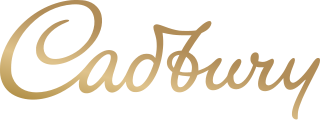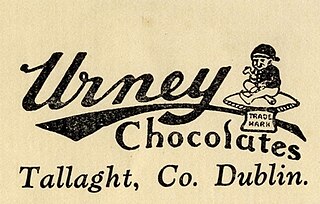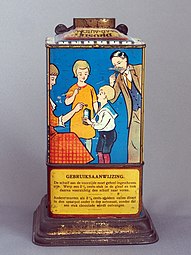
Cadbury, formerly Cadbury's and Cadbury Schweppes, is a British multinational confectionery company owned by Mondelez International since 2010. It is the second-largest confectionery brand in the world, after Mars. Cadbury is internationally headquartered in Greater London, and operates in more than 50 countries worldwide. It is known for its Dairy Milk chocolate, the Creme Egg and Roses selection box, and many other confectionery products. One of the best-known British brands, in 2013 The Daily Telegraph named Cadbury among Britain's most successful exports.

Haarlem is a city and municipality in the Netherlands. It is the capital of the province of North Holland. Haarlem is situated at the northern edge of the Randstad, one of the more populated metropolitan areas in Europe; it is also part of the Amsterdam metropolitan area. Haarlem had a population of 162,543 in 2021.

A chocolate bar is a confection containing chocolate, which may also contain layerings or mixtures that include nuts, fruit, caramel, nougat, and wafers. A flat, easily breakable, chocolate bar is also called a tablet. In some varieties of English and food labeling standards, the term chocolate bar is reserved for bars of solid chocolate, with candy bar used for products with additional ingredients.
Mars Inc. is an American multinational manufacturer of confectionery, pet food, and other food products and a provider of animal care services, with US$45 billion in annual sales in 2022; that year Forbes ranked the company as the fourth-largest privately held company in the United States. Headquartered in McLean, Virginia, the company is entirely owned by the Mars family.

Milk chocolate is a form of solid chocolate containing cocoa, sugar and milk. It is the most consumed type of chocolate, and is used in a wide diversity of bars, tablets and other confectionery products. Milk chocolate contains smaller amounts of cocoa solids than dark chocolates do, and contains milk solids. While its taste has been key to its popularity, milk chocolate was historically promoted as a healthy food, particularly for children.

Coenraad Johannes van Houten was a Dutch chemist and chocolate maker known for the treatment of cocoa mass with alkaline salts to remove the bitter taste and make cocoa solids more water-soluble; the resulting product is still called "Dutch process chocolate". He has also been credited with introducing a method for pressing the fat from roasted cocoa beans, though this was in fact his father Casparus van Houten's invention.

The Droste effect, known in art as an example of mise en abyme, is the effect of a picture recursively appearing within itself, in a place where a similar picture would realistically be expected to appear. This produces a loop which in theory could go on forever, but in practice only continues as far as the image's resolution allows.

Wilbur Chocolate is one of four brands manufactured by Cargill Cocoa & Chocolate North America. Most of the Wilbur brand products were produced in plants chocolate manufacturing company located in Lititz, Pennsylvania.

Nestlé UK Ltd., trading as Rowntree's, is a British confectionery brand and a former business based in York, England. Rowntree developed the Kit Kat, Aero, Fruit Pastilles, Smarties brands, and the Rolo and Quality Street brands when it merged with Mackintosh's in 1969 to form Rowntree Mackintosh Confectionery. Rowntree's also launched After Eight thin mint chocolates in 1962. The Yorkie and Lion bars were introduced in 1976. Rowntree's also pioneered the festive selection box which in the UK have been a staple gift at Christmas for over a century.

Leaf International BV was a confectionery company founded in the 1940s. Leaf had sales of approximately €527m (2010) and 2,400 employees. It had 11 factories in seven countries. Leaf was owned by CVC Capital Partners, Nordic Capital, and management. Bengt Baron was the CEO of Leaf.

Terry's is a British chocolate and confectionery brand. The original company was founded in 1767 in York, England, and was part of the city's famous confectionery triumvirate along with Rowntree's and Cravens. The company's headquarters and factory, Terry's Chocolate Works, was closed by Kraft in 2005 and production moved to Kraft factories in Europe. The business returned to the UK in 2019 as Terry's Chocolate Co located in London. Their best known products include Terry's Chocolate Orange and Terry's All Gold box of assorted chocolates which were both introduced in the 1930s.
Barry Callebaut AG is a Swiss-Belgian cocoa processor and chocolate manufacturer, with an average annual production of 2.3 million tonnes of cocoa & chocolate . It was created in 1996 through the merging of the French company Cacao Barry and the Belgian chocolate producer Callebaut. It is currently based in Zürich, Switzerland. It was created in its present form by Klaus Johann Jacobs. In 2019, the company had 61 production sites, located in Europe, Africa, America and Asia.

Duyvis is a Dutch brand of salty snacks, peanuts and nuts. Dip sauces are also sold under the Duyvis brand.
The following outline is provided as an overview of and topical guide to chocolate:

Corbion N.V., formerly Centrale Suiker Maatschappij (CSM) N.V., is a Dutch food and biochemicals company headquartered in Amsterdam, Netherlands. It produces bioingredient-based foods, chemicals derived from organic acids, and lactic acid based solutions for the food, chemical and pharmaceutical industries. The company was founded on August 21, 1919.

Urney Chocolates was an Irish confectionery manufacturing business founded by the Gallagher family in County Tyrone, which once operated one of the largest chocolate factories in Europe. After being sold as a going concern, ultimately to what would become Unilever, the factory closed in 1980. The brand was later operated by L.C. Confectionery Ltd., and is now handled by Hazelbrook Confectionery, based in County Kildare, Ireland.
Cadbury is a British multinational confectionery company owned by Mondelēz International. It is the second largest confectionery brand in the world after Mars. Cadbury is headquartered in Uxbridge, London, and operates in more than fifty countries worldwide. Its best known products include Dairy Milk chocolate.

Wawel is a Polish confectionery company, producing many varieties of chocolates, wafers, chocolate bars and snacks. Wawel is also a well-recognized brand of candy in Poland.
Mars Nederland is the Dutch division of Mars, Incorporated, a privately held multi-national company in food, pet care products, and confectionery products. It has its headquarters and main production site in Veghel, North Brabant known as Mars Nederland B.V. A second production site is located in Oud-Beijerland, South Holland. The chocolate factory in Veghel is the largest production site owned by Mars, Incorporated, and is among the largest chocolate factories in the world.

August Maschmeijer Jr. was an organic chemist.



































